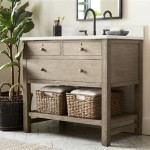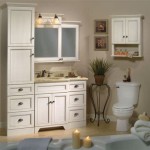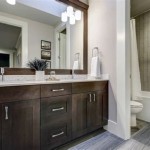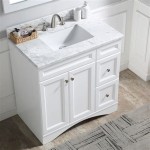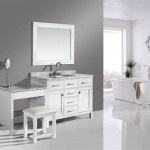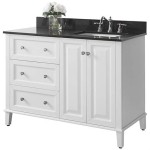```html
Built-In Makeup Vanity: Transforming Bedrooms into Personal Sanctuaries
The incorporation of a built-in makeup vanity into a bedroom design represents a significant upgrade in both functionality and aesthetic appeal. This customized feature transcends the limitations of freestanding vanities, offering a seamless integration with the existing room structure and providing a dedicated space for grooming and self-care. Consideration should be given to numerous factors when planning a built-in vanity, including spatial constraints, storage needs, lighting requirements, and overall design coherence.
Built-in vanities maximize available space, particularly in smaller bedrooms where every square inch is valuable. Unlike mobile vanities that can occupy significant floor area, a built-in unit can be tailored to fit into alcoves, corners, or even integrated into existing closet spaces. This approach can free up valuable room for other furniture or activities. Furthermore, the permanence of the design allows for the concealment of wiring and plumbing, contributing to a cleaner and more streamlined appearance. The strategic placement of a built-in vanity can also enhance the natural light within the room, improving visibility for makeup application and other grooming tasks.
The customizability of built-in vanities allows for the creation of a space that perfectly caters to individual needs and preferences. Homeowners can select the materials, finishes, and hardware that best complement the existing bedroom décor, ensuring a harmonious and cohesive design. This bespoke approach allows for the incorporation of personal touches, such as custom drawer organizers, specialized lighting fixtures, and unique countertop materials.
Optimizing Space and Functionality
One of the primary advantages of a built-in makeup vanity is its capacity to optimize space utilization. By integrating the vanity into the existing architecture, designers can avoid the awkward gaps and inefficiencies often associated with freestanding furniture. Corner vanities, for example, can effectively utilize otherwise underutilized areas, while wall-mounted units can free up floor space for easier movement within the room. Integrated storage solutions, such as pull-out shelves, hidden compartments, and custom drawer dividers, can further enhance the organizational capabilities of the vanity, keeping makeup, skincare products, and accessories neatly organized and readily accessible. The strategic integration of power outlets and USB ports can also streamline the use of electronic grooming tools, such as hair dryers and curling irons, minimizing clutter and maximizing convenience.
The design of a built-in vanity should prioritize ergonomics and functionality. The height of the vanity should be carefully considered to ensure comfortable seating and proper posture during makeup application. Ample legroom is essential, and the placement of the mirror should allow for optimal visibility without straining the neck. The choice of seating is also crucial. A comfortable and supportive chair or stool is essential for extended grooming sessions. Furthermore, the design should incorporate adequate task lighting to illuminate the face evenly and accurately, minimizing shadows and ensuring precise makeup application.
Beyond its functional aspects, a built-in vanity can also contribute significantly to the overall aesthetic of the bedroom. The choice of materials and finishes can be used to create a focal point within the room, adding visual interest and enhancing the overall design scheme. A sleek and minimalist vanity can create a contemporary and uncluttered look, while a more ornate and detailed vanity can add a touch of elegance and sophistication. The integration of decorative elements, such as decorative mirrors, statement lighting fixtures, and unique hardware, can further personalize the space and reflect the homeowner's individual style.
Illumination: The Key to Flawless Application
Adequate and well-placed lighting is paramount in creating a functional and effective makeup vanity. The goal is to achieve even and diffused illumination that accurately reflects skin tone and minimizes shadows. Natural light is ideal, but it is not always readily available. Therefore, artificial lighting must be carefully planned to compensate for the lack of natural light. A combination of ambient, task, and accent lighting is often the most effective approach.
Task lighting, specifically designed for makeup application, should be positioned around the mirror to provide direct and focused illumination. Options include vanity lights, sconces, and LED strips. The color temperature of the light source is crucial. A neutral white light (around 3500-4000 Kelvin) is generally recommended, as it mimics natural daylight and provides the most accurate color representation. Avoid lights that are too warm or too cool, as they can distort the appearance of makeup. Dimmable lighting is also beneficial, allowing for adjustments based on the time of day and the desired level of illumination.
Ambient lighting provides overall illumination for the vanity area and the surrounding room. Recessed lighting, chandeliers, or pendant lights can be used to create a balanced and inviting atmosphere. Accent lighting can be used to highlight specific features of the vanity, such as decorative mirrors or artwork. LED strip lights can be used to create a subtle and indirect glow, adding a touch of elegance and sophistication to the space. The integration of smart lighting controls allows for convenient adjustments to the lighting levels and color temperature, enhancing the overall user experience.
The placement of lighting fixtures is as important as the type of lighting used. Lights should be positioned at eye level to avoid creating harsh shadows or glare. Sconces mounted on either side of the mirror provide even and symmetrical illumination, while a vanity light positioned above the mirror can provide additional task lighting. Avoid placing lights directly above the head, as this can create unflattering shadows on the face. The goal is to create a well-lit and comfortable space that facilitates accurate and effortless makeup application.
Storage Solutions: Maximizing Organization and Accessibility
Efficient storage is essential for maintaining a clutter-free and organized makeup vanity. A well-designed built-in vanity should incorporate a variety of storage solutions to accommodate different types of makeup, skincare products, and accessories. Drawers, shelves, and cabinets are the most common storage elements, but the specific configuration should be tailored to individual needs and preferences. Custom drawer organizers, such as dividers and trays, can help to keep makeup items neatly separated and easily accessible. Pull-out shelves can provide convenient access to larger items, such as hair dryers and curling irons. Hidden compartments can be used to store valuables or personal items.
The depth and height of drawers should be carefully considered to accommodate different sized items. Shallow drawers are ideal for storing makeup palettes, while deeper drawers are suitable for storing bottles and jars. Adjustable shelves can provide flexibility in storage arrangements, allowing for the accommodation of items of varying heights. Clear acrylic organizers can be used to display makeup products and accessories, making them easily visible and accessible. A dedicated space for storing brushes and applicators is also essential. Brush holders, cups, or drawers with custom dividers can be used to keep brushes organized and prevent them from becoming damaged.
Beyond traditional storage elements, a built-in vanity can also incorporate more innovative storage solutions. Built-in power outlets and USB ports can be used to charge electronic grooming tools, minimizing clutter and maximizing convenience. Integrated trash cans can provide a discreet and hygienic way to dispose of used cotton swabs and other waste. A built-in mirror with integrated lighting can provide additional storage space for small items, such as lipsticks and eyeliners. The goal is to create a storage system that is both functional and aesthetically pleasing, contributing to the overall organization and beauty of the bedroom.
The choice of materials and finishes for storage elements can also contribute to the overall design of the vanity. Solid wood drawers and cabinets can add a touch of elegance and sophistication, while laminate or veneer finishes can provide a more affordable and durable option. Glass or acrylic drawer fronts can allow for easy visibility of contents, while closed drawers can provide a more streamlined and minimalist look. The hardware chosen for drawers and cabinets can also contribute to the overall aesthetic of the vanity. Knobs, pulls, and handles in a variety of styles and finishes can be used to personalize the space and complement the existing bedroom décor.
```
Built In Bedroom Vanity Design Ideas

Built In Bedroom Vanity Design Ideas

12 Stunning Bedroom Makeup Vanity Ideas You Need To See Decoist

Somerset Baths Via Kitchen Designs By Debra Georgiana Design

Built In Bedroom Vanity Nook Ideas

Is The Built In Makeup Vanity Dated Yay Or Nay Colour Trends

Built In Makeup Vanity Traditional Bathroom Jan Gleysteen Architects

20 Best Makeup Vanity Options For Every Stylish Aesthetic In 2024

Custom Beaded Inset Makeup Vanity With Lucite Legs Fusion Bathroom Other By Christine Lakas The Designer Llc

Fufu Gaga 5 Drawers White Makeup Vanity Table Wooden Dressing Desk With Mirror And 3 Tier Storage Shelves 55 1 X 31 15 7 In Kf210106 01 The Home
